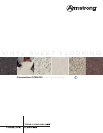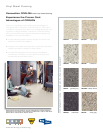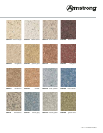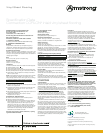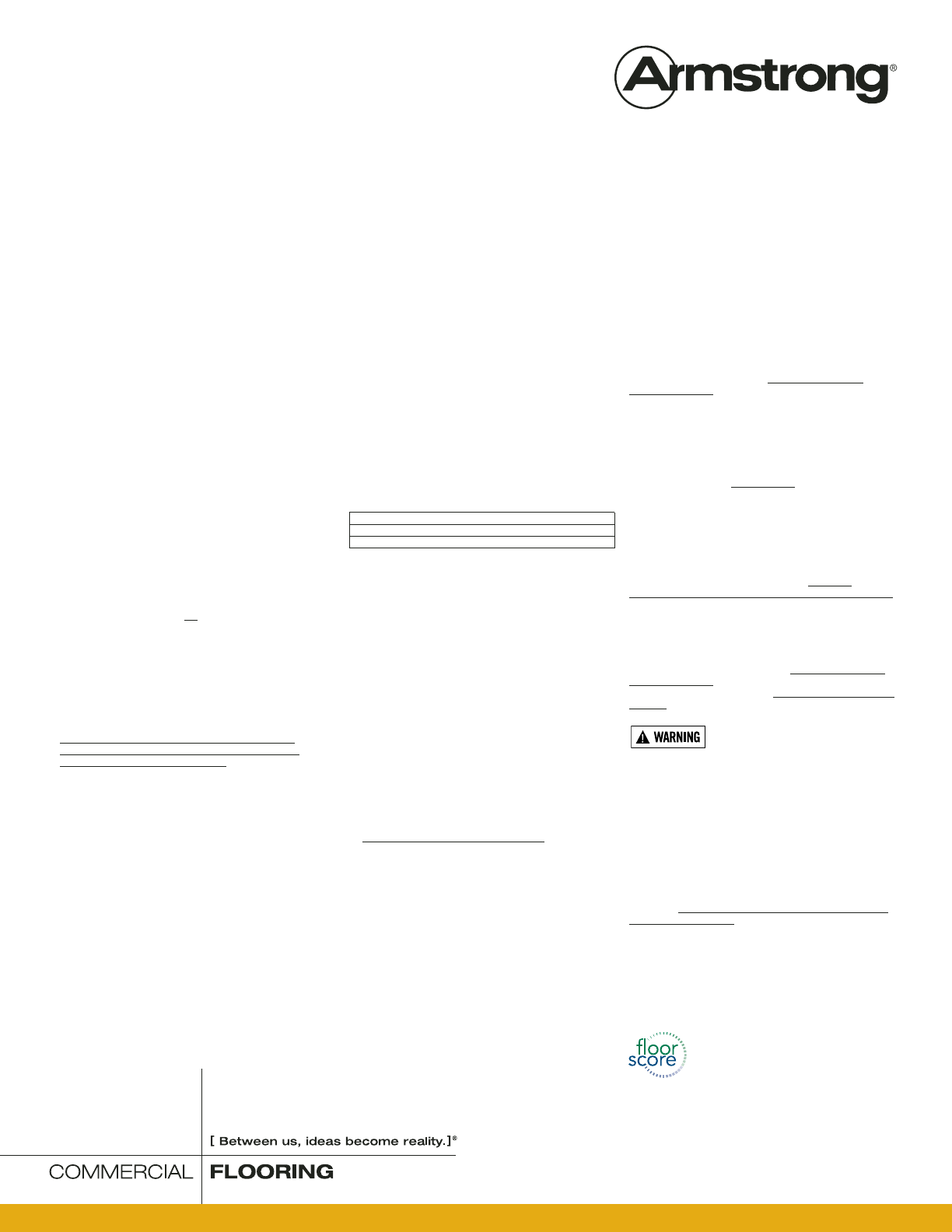
Printed in United States of America
© 2005 AWI Licensing Company
Floor Score trademark owned by Resilient Flooring
Institute
All other trademarks owned by AWILicensing Company
F-6605-606
ARMSTRONG FLOOR PRODUCTS
Armstrong World Industries, Inc.
P.O. Box 3001
Lancaster, PA 17604 U.S.A.
Armstrong World Industries Canada Ltd.
6911 Decarie Blvd.
Montreal, Quebec H3W 3E5 Canada
1. PRODUCT NAME
Armstrong Connection CORLON inlaid sheet flooring
2. PRODUCT DESCRIPTION
Material
A polyurethane-coated wear layer composed of polyvinyl
chloride resin, stabilizers, filler and pigments on a backing
suitable for use on approved subfloors on all grade levels.
Construction and Colors
Random, multisized vinyl chips embedded in a vinyl matrix. Color
and pattern detail are dispersed throughout the thickness of the
wear layer. Color pigments are insoluble in water and resistant to
cleaning agents and light.
Size
6.0 ft. (1.83 m) wide, up to 94.5 ft. (28.8 m) long
Gauge (nominal)
0.080 in. (2.0 mm) overall
0.050 in. (1.27 mm) wear layer
Limitations
Connection CORLON should not be used in the following areas:
■ Hospital operating rooms
■ Heavy industrial and exterior areas.
■ Commercial kitchens and commercial food processing areas.
■ Where pointed spikes such as golf or track shoes will be used.
■ Where the floor will be subjected to unusually concentrated
static or dynamic loads.
NOTE: Concentrated static and dynamic loads such as hospital
beds, roll-out bleachers, portable x-ray machines, etc. may
visibly damage resilient as well as other types of floor coverings.
For questions regarding product suitability and detailed
instructions for floor preparation and installation in these
applications, please contact Armstrong.
Suitable for Application Over
■ Concrete, terrazzo, and other dry, structurally sound monolithic
subfloors on all grade levels.
■ Suspended wood subfloor construction with approved wood
underlayments, and a minimum of 18 in. (45.7 cm) well-
ventilated air space below.
■ Most metal floors and most existing single-layer resilient floors
on approved underlayments.
■ Radiant-heated subfloors with a maximum surface
temperature of 85˚ F (29˚ C).
Unsuitable for Application Over
■ Subfloors where excessive moisture or alkali is present.
■ Sleeper-constructed wood subfloors
■ Lightweight aggregate concrete subfloors having a density of
less than 90 lbs. per cu. ft. (1442 kg/m
3
) or cellular concrete
having a plastic (wet) density less than 100 lbs. per cu. ft.
(1602 kg/m
3
) [94 lbs. per cu. ft. (1506 kg/m
3
) dry weight] or
concrete having a compressive strength of less than 3500 psi
(24 MPa). Concrete slabs with heavy static and/or dynamic
loads should have higher design strengths and densities
calculated to accommodate such loads.
Concrete curing agents, sealers, hardeners, or parting
agents
should be removed.
3. TECHNICAL DATA
Shipping Weight
6.0 lbs./sq. yd. (3.3 kg/m
2
)
Gloss (typical value)
60 degrees specular: approximately 5-15
Reference Specifications
ASTM F 1303, Type II, Grade 1, Class A backing.
Backing is suitable for installation on all grade levels.
Static Load Limit
ASTM F 970 (modified)
500 lbs./sq. in. (35.16 kg/cm
2
)
ASTM F 970 modified by specifying a higher load on a smaller
diameter tip. All other conditions are standard.
NOTE: Floors should be protected from sharp-point loads and
heavy static loads. High-heeled traffic [1000 psi (70.3 kg/cm
2
)
or more] may visibly damage wood, resilient and other floor
coverings.
Comparative Subjective Property Ratings
Durability: Very Good
Maintainability: Excellent
Resilience: Very Good
Subjective ratings (excellent, very good, good, fair) are in
relation to other Armstrong commercial resilient floors. Ratings
are not directly related to any one test. They are broadly based
on tests and experience of Armstrong Research and
Development under varying conditions and circumstances.
These ratings should not be used for comparison to ratings
used by other manufacturers to rank their own products.
Fire Test Data
ASTM E 648 Flooring Radiant Panel Critical Radiant Flux –
0.45 watts/cm
2
or more, Class I
ASTM E 662 Smoke Chamber Specific Optical Smoke Density –
450 or less
Numerical flammability ratings alone may not define the
performance of the product under actual fire conditions. These
ratings are provided only for use in the selection of products to
meet the specified limits.
4. INSTALLATION
Job Conditions
Subfloors/underlayments shall be dry, clean and smooth. They
shall be free from paint, varnish, solvents, wax, oil, existing
adhesive residue or other foreign matter.
For more detailed requirements of concrete, wood and metal
subfloors, as well as wood and trowelable underlayments, refer
to Armstr
ong Guaranteed Installation Systems manual, F-5061.
Calcium Chloride Tests for moisture must be conducted.
Armstrong offers a guideline of a maximum acceptable
moisture emission level of 5.0 lbs. per 1000 sq. ft. per 24
hours. Bond Tests should also be conducted for compatibility
with the substrate. When testing for alkalinity, the allowable
readings for the installation of Armstrong flooring are 5 to 9 on
the pH scale.
Temperature shall be maintained at a minimum of 65° F
(18° C) and a maximum of 100° F (38° C) for 48 hours prior to
installation, during installation and 48 hours after completion
when using Armstrong S-599 Adhesive. When using Armstrong
S-240 Epoxy Adhesive, the temperature shall be maintained at
a minimum of 65° F (18° C) and a maximum of 85° F (29° C) for
48 hours prior to installation, during installation and 48 hours
after completion. A minimum temperature of 55° F (13° C) shall
be maintained thereafter. Condition all flooring materials and
adhesives to room temperature at least 48 hours prior to start-
ing installation. Protect all materials from the direct flow of heat
from hot-air registers, radiators, or other heating fixtures
and appliances.
Procedure
Connection CORLON must be installed using Armstrong
S-599 Adhesive full spread in field areas and Armstrong S-580
Adhesive in flash cove areas. Recess scribe all seams. Seams
must be heat-welded or sealed with Armstrong S-761 Seam
Adhesive. Connection Corlon installed in areas subjected to
heavy static and dynamic loads must be installed with
Armstrong S-240 Epoxy Adhesive in the field area. Detailed
instructions may be found in the Armstrong Guaranteed
Installation Systems manual, F-5061.
5. MAINTENANCE
Connection CORLON is designed to be maintained by tradi-
tional resilient flooring maintenance methods. This floor may be
maintained by polishing, spray-buffing or dry buffing. The
urethane protective finish can make initial maintenance easier,
as well as reduce ongoing maintenance procedures.
Initial Maintenance Immediately
After Installation
■ Sweep or vacuum thoroughly.
■ Damp mop with a dilute neutral detergent solution such
as Armstrong S-485 Floor Cleaner – carefully wiping up
black marks and excessive soil.
■ Do not wet wash or scrub the floor for at least four to
five days after installation.
Preparation for Commercial Use
Refer to maintenance methods detailed in Armstrong
Commercial Resilient Flooring Maintenance Recommendations
booklet, F-8663.
6. WARRANTIES
Armstrong warrants its regular (first quality) commercial floors
and wall base to be free from manufacturing defects and
warrants the installation integrity for five years from the date of
purchase, if installed according to the Armstrong Guaranteed
Installation Systems manual, F-5061. This warranty extends
only to the original end-user. See Armstrong Commercial Floor
Warranty, F-3349 or visit www.armstrong.com for warranty
details, limitations and exclusions.
DO NOT SAND, DRY SWEEP, DRY SCRAPE, DRILL, SAW,
BEADBLAST OR MECHANICALLY CHIP OR PULVERIZE
EXISTING RESILIENT FLOORING, BACKING, LINING FELT,
ASPHALTIC "CUT BACK" ADHESIVES OR OTHER
ADHESIVES. These products may contain either asbestos
fibers and/or crystalline silica. Avoid creating dust. Inhalation
of such dust is a cancer and respiratory tract hazard. Smoking
by individuals exposed to asbestos fibers greatly increases the
risk of serious bodily harm. Unless positively certain that a
product is a non-asbestos containing product, you must
presume it contains asbestos. Regulations may require that
the material be tested to determine asbestos content. See
current edition of the Resilient Floor Covering Institute (RFCI)
publication Recommended W
ork Practices for the Removal of
Resilient Floor Coverings
for instructions on removing all
resilient floor covering structures.
For specifications or samples,
web site: www.armstrong.com/flooring
phone: 1 877 ARMSTRONG (276 7876)
fax: 1 800 599 9335
For more information, visit
www.armstrong.com/floorscore
Specification Data
Connection CORLON
®
inlaid vinyl sheet flooring
Vinyl Sheet Flooring



